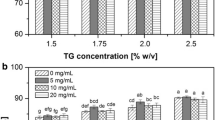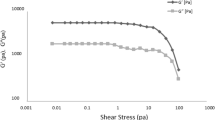Abstract
In this study, flow properties of ternary hydrocolloid systems were investigated in organic acid–sucrose model systems. For this purpose, xanthan gum, pectin and carboxymethyl cellulose (CMC) that commonly used in food industry as a structure developer were incorporated in organic acid (citric acid or tartaric acid)–sucrose systems depending on a constructed mixture design and some physicochemical characteristics, steady shear and dynamic shear rheological properties of final solutions were investigated. And, optimization was performed to find the maximum and minimum values for each studied parameters using desirability function. Among the hydrocolloids, CMC showed the highest consistency coefficient (K) in citric acid–sucrose and tartaric acid–sucrose model systems compared to xanthan gum and pectin. All mixture components showed significant effect on the studied parameters. The pectin generally decreased the values of steady shear and dynamic oscillatory shear parameters, and it was observed that pectin was the most effective component on the acidity increase in the model systems. Regression models were constructed for each parameter which could be used effectively for the estimation of parameter value in the out of the studied range. It could be said that the CMC may be used instead of the pectin in organic acid–sucrose model systems.






Similar content being viewed by others
References
Mirhosseini H, Amid BT (2012) A review study on chemical composition and molecular structure of newly plant gum exudates and seed gums. Food Res Int 46:387–398
Gómez-Díaz D, Navaza JM (2003) Comments about rheological effects of food hydrocolloids addition. Food Agric Environ 1(2):98–102
Hayati IN, Ching CW, Rozaini MZH (2016) Flow properties of o/w emulsions as affected by xanthan gum, guar gum and carboxymethyl cellulose interactions studied by a mixture regression modeling. Food Hydrocoll 53:199–208
Dogan M, Kayacier A, Ic E (2007) Rheological characteristics of some food hydrocolloids processed with gamma irradiation. Food Hydrocoll 21:392–396
Toker OS, Dogan M, Caniyilmaz E, Ersöz NB, Kaya Y (2013) The effects of different gums and their interactions on the rheological properties of a dairy dessert: a mixture design approach. Food Bioprocess Technol 6(4):896–908
Krumel KL, Sarkar N (1975) Flow properties of gums useful to the food industry. Food Technol 29:36–44
Speers RA, Tung MA (1986) Concentration and temperature dependence of flow behavior of xanthan gum dispersions. J Food Sci 51:96–98
Kayacier A, Dogan M (2006) Rheological properties of some gums-salep mixed solutions. J Food Eng 72:261–265
Koocheki A, Mortazavi SA, Shahidi F, Razavi SMA, Taherian AR (2009) Rheological properties of mucilage extracted from Alyssum homolocarpum seed as a new source of thickening agent. J Food Eng 91:490–496
Marcotte M, Hoshahili ART, Ramaswamy HS (2001) Rheological properties of selected hydrocolloids as a function of concentration and temperature. Food Res Int 34(8):695–703
Walkenström P, Kidman S, Hermansson A, Rasmussen PB, Hoegh L (2003) Microstructure and rheological behaviour of xanthan/pectin mixed gels. Food Hydrocoll 17:593–603
Dogan M, Toker OS, Aktar T, Goksel M (2013) Optimization of gum combination in prebiotic ınstant hot chocolate beverage model system in terms of rheological aspect: mixture design approach. Food Bioprocess Technol 6(3):783–794
Ahmed J, Ramaswamyb HS, Ngadi MO (2005) Rheological characteristics of arabic gum in combination with guar and xanthan gum using response surface methodology: effect of temperature and concentration. Int J Food Prop 8(2):179–192
Bayarri S, Gonzales-Tomas L, Costell E (2009) Viscoelastic properties of aqueous and milk systems with carboxymethyl cellulose. Food Hydrocoll 23(2):441–450
Beaulieua M, Turgeona SL, Doublier JL (2001) Rheology, texture and microstructure of whey proteins/low methoxyl pectins mixed gels with added calcium. Int Dairy J 11:961–967
AOAC (2000) Official methods of analysis, 17th edn. Association of Official Analytical Chemists Inc., Arlington
American Association of Cereal Chemist (AACC) (1995) Approved methods of the AACC, 9th edn. The Association, St Paul.
Ahmed J, Ramaswamy HS (2004) Effect of high-hydrostatic pressure and concentration on rheological characteristics of xanthan gum. Food Hydrocoll 18:367–373
Steffe JF (1996) Rheological methods in food process engineering, vol 33. Freeman Press, East Lansing, pp 358–360
Gunasekaran S, Ak MM (2000) Dynamic oscillatory shear testing of foods—selected applications. Trends Food Sci Technol 11(3):115–127
Evageliou V, Richardson RK, Morris ER (2000) Effect of pH, sucrose type and thermal annealing on high-methoxy pectin gels. Carbohydr Polym 42:245–259
Cengiz E, Doğan M, Karaman S (2013) Characterization of rheological interactions of Gleditsia triacanthos gum with some hydrocolloids: effect of hydration temperature. Food Hydrocoll 32:453–462
Mirhosseini H, Tan CP, Hamid NSA, Yusof S (2008) Optimization of the contents of Arabic gum, xanthan gum and orange oil affecting turbidity, average particle size, polydispersity index and density in orange beverage emulsion. Food Hydrocoll 22(7):1212–1223
Bryant CM, McClements DJ (2000) Influence of xanthan gum on physical characteristics of heat-denatured whey protein solutions and gels. Food Hydrocoll 14(4):383–390
Kermani ZJ, Shpigelman A, Pham HTT, Van Loey AM, Hendrickx ME (2015) Functional properties of citric acid extracted mango peel pectin as related to its chemical structure. Food Hydrocoll 44:424–434
Bourne MC (2002) Physics and texture. Food texture and viscosity. Concept and measurement. Academic Press, Harcourt Place, London, pp 59–106 Chapter 3
de Castro RJS, Sato HH (2014) Functional properties and growth promotion of bifidobacteria and lactic acid bacteria strains by protein hydrolysate susing a statistical mixture design. Food Biosci 7:19–30
Ouedrhiri W, Balouiri M, Bouhdid S, Moja S, Chahdi FO, Taleb M, Greche H (2016) Mixture design of Origanum compactum, Origanum majorana and Thymus serpyllum essential oils: optimization of their antibacterial effect. Ind Crops Prod 89:1–9
Dogan M, Aktar T, Toker OS, Tatlisu NB (2015) Combination of the simple additive (saw) approach and mixture design to determine optimum cocoa combination of the hot chocolate beverage. Int J Food Prop 18:1677–1692
Dogan M, Ersoz NB, Toker OS, Kaya Y, Caniyilmaz E (2014) Optimization of gum combination for instant pudding based on creep and recovery parameters by mixture design approach. Eur Food Res Technol 238:47–58
Yilmaz MT, Yildiz O, Yurt B, Toker OS, Karaman S, Bastürk A (2015) A mixture design study to determine interaction effects of wheat, buckwheat, and rice flours in an aqueous model system. LWT—Food Sci Technol 61:583–589
Karaman S, Yilmaz MT, Kayacier A (2011) Simplex lattice mixture design approach on the rheological behavior of glucomannan based salep-honey drink mixtures: an optimization study based on the sensory properties. Food Hydrocoll 25:1319–1326
Kayacier A, Yüksel F, Karaman S (2014) Simplex lattice mixture design approach on physicochemical and sensory properties of wheat chips enriched with different legume flours: an optimization study based on sensory properties. LWT-Food Sci Technol 58(2):639–648
Abid M, Cheikhrouhou S, Renard CM, Bureau S, Cuvelier G, Attia H, Ayadi MA (2017) Characterization of pectins extracted from pomegranate peel and their gelling properties. Food chem 215:318–325
MacDougall AJ, Ring SG (2004) Pectic Polysaccharides. In: Tomasik P (ed) Chemical and functional properties of food saccharides. CRC Press, Boca Raton, London, New York, Washington, DC, pp 181–196 Chapter 12
Yang XH, Zhu WL (2007) Viscosity properties of sodium carboxymethylcellulose solutions. Cellulose 14(5):409–417
Giannouli P, Morris ER (2003) Cryogelation of xanthan. Food Hydrocoll 17(4):495–501
Lii C, Liaw SC, Lai VMF, Tomasik P (2002) Xanthan gum–gelatin complexes. Eur Polym J 38:1377–1381
Acknowledgements
This study was supported by Erciyes University Scientific Research and Project Unit as master thesis project. (Code: FYL-2013-4389).
Author information
Authors and Affiliations
Corresponding author
Ethics declarations
Conflict of interest
The authors declare that they have no conflict of interest.
Compliance with ethics requirements
This article does not contain any studies with human or animal subjects.
Rights and permissions
About this article
Cite this article
Ozgur, A., Dogan, M. & Karaman, S. Rheological interactions of the xanthan gum and carboxymethyl cellulose as alternative to pectin in organic acid–sucrose model system: simplex lattice mixture design approach. Eur Food Res Technol 243, 1041–1056 (2017). https://doi.org/10.1007/s00217-016-2809-7
Received:
Revised:
Accepted:
Published:
Issue Date:
DOI: https://doi.org/10.1007/s00217-016-2809-7




